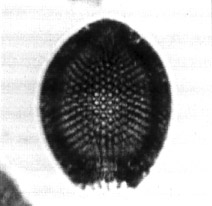 Cryptocarpium
azyx (Sanfilippo and Riedel)
Cryptocarpium
azyx (Sanfilippo and Riedel) Cryptocarpium
azyx (Sanfilippo and Riedel)
Cryptocarpium
azyx (Sanfilippo and Riedel)Carpocanistrum azyx Sanfilippo and Riedel, 1973, p.530, pl.35, fig.9; Riedel and Sanfilippo, 1978a, p.67, pl.4, fig.5
Cryptocarpium azyx (Sanfilippo and Riedel) Sanfilippo and Riedel, 1992, p.6, pl.2, fig.21
Cephalis within upper part of thoracic wall, and its structure consequently obscure - it is not a small sphere, but a large structure (at least distally) of widely separated, narrow bars forming a loose "basket". Thorax regularly ellipsoidal, with smooth surface, a somewhat constricted peristome, and thick wall perforated by small, closely spaced, circular pores longitudinally aligned. Peristome narrow, probably with an inwardly directed shelf, terminating in small thorns connected by ridges with the bars between distalmost thoracic pores, and perhaps the remnant of a previously existing abdomen (Sanfilippo and Riedel, 1973).
In Saunders et al., 1985 (p.412) specimens with abdominal lattice are excluded.
Based on 30 specimens. Total length 105-140 mm, maximum breadth 85-120 mm (Sanfilippo and Riedel, 1973).
Cephalis within upper part of thoracic wall. Thorax with thick wall, pores small, closely spaced and longitudinally aligned, and peristome inwardly directed (Riedel and Sanfilippo, 1978a).
This species is distinguished from Cryptocarpium ornatum, which co-occurs and ranges lower, by the lack of a third segment and thicker wall. Superficially similar Neogene species of Carpocanistrum are smaller (Sanfilippo et al., 1985).
The variable features of this densely pored, two-segmented, ovoid form are the breadth and length of the thorax, and the thickness of the wall, which is sometimes greater than in the illustrated specimens (Sanfilippo et al., 1985).
C. azyx is found in most tropical late Eocene localities. Absent in DSDP Site 140 Africa). Its morphotypic first appearance defines the base of the Cryptocarpium azyx Zone and it becomes extinct within the Cryptocarpium ornatum Zone.
This species appears to have evolved from a non-tuberose precursor of Theocyrtis tuberosa or from Cryptocarpium ornatum as suggested by Sanfilippo and Riedel (1973, p.530). It seems to have left no descendants. Because of the apparent relationships of this species, its present placement in the family Carpocaniidae is not very satisfactory (see also discussion of Cryptocarpium ornatum).